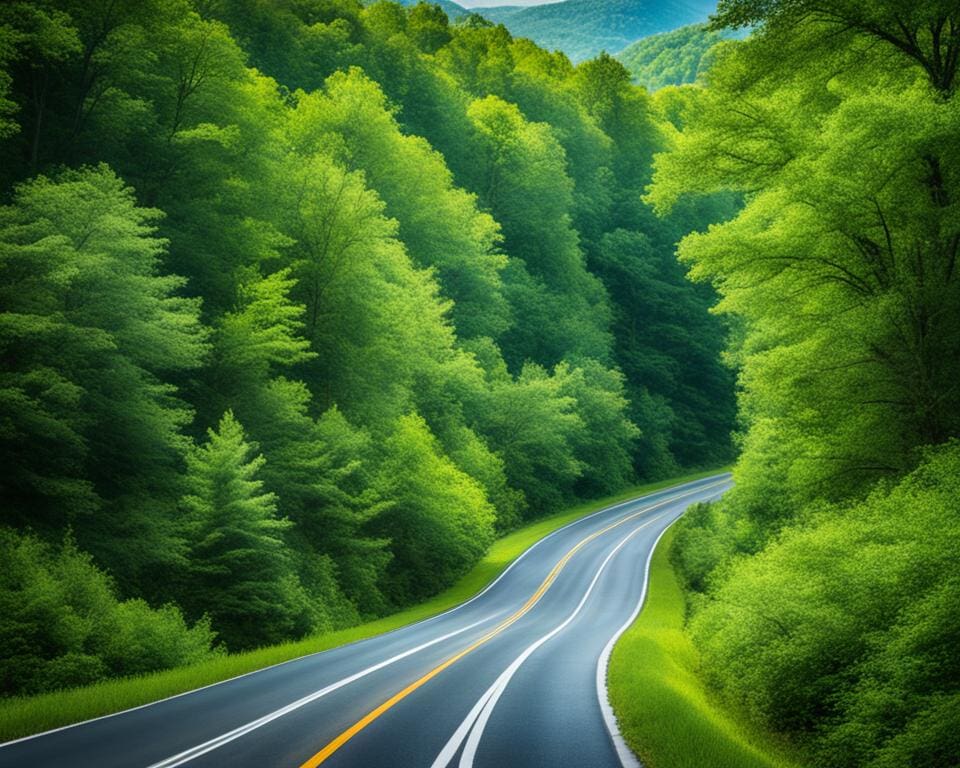The Blue Ridge Parkway stretches 469 miles. It connects Shenandoah National Park in Virginia to Great Smoky Mountains National Park in North Carolina. Known as America’s Favorite Scenic Drive, it draws over 15 million visitors yearly. They come for the stunning vistas and landscapes that show the beauty of the Southern Appalachians. This drive is perfect for car tours, offering a journey through the beautiful Blue Ridge Mountains.
It features gentle hills and high peaks, over 6,000 feet tall. With 168 bridges and 27 tunnels, it gives travelers amazing views at every turn. Each season brings its own beauty, making it a great place for nature fans and road trippers.
The Scenic Beauty of the Blue Ridge Parkway
The Blue Ridge Parkway is a work of natural art. It spans 469 miles, connecting Shenandoah National Park in Virginia to Great Smoky Mountains National Park in North Carolina. It offers stunning views and beautiful hiking trails for its visitors.
Introduction to the Blue Ridge Parkway
The Blue Ridge Parkway is incredibly popular and managed by the National Park Service. It lets you see diverse environments. The beauty here changes with the seasons, offering flowers in spring and lush greenery in summer. The weather also determines the best times for visits and hikes.
Unique Landscape Features
This parkway is more than just a road; it showcases fascinating geography. It’s surrounded by mountains and valleys, offering chances to see wildlife. Sites like Peaks of Otter and Craggy Gardens are great for photos. The elevation changes create unique climates, making every turn a new discovery.
Seasonal Attractions and Vistas
Each season adds its charm to the parkway. Spring has bright flowers, and summer offers green landscapes perfect for hiking. Autumn colors are stunning, and winter brings peaceful snow scenes. Year-round, you’ll find waterfalls, cultural spots, and trails that show the parkway’s beauty.

Top Attractions Along the Blue Ridge Parkway
The Blue Ridge Parkway draws in visitors with lots of attractions. It gives everyone something special to see or do. You can find overlooks, parks, and historic places by using the Parkway map.
Must-See Overlooks and Scenic Stops
The Parkway has many scenic spots that make the drive unforgettable. You can see Crabtree Falls, Virginia’s highest waterfall, and Mabry Mill, a symbol of Appalachian culture. Each milepost is a guide to these beautiful sights.
The Swinging Bridge over the Toccoa River is also a must-see. It is one of the longest of its kind east of the Mississippi. It’s perfect for taking amazing photos.
Notable Parks and Outdoor Activities
There are lots of outdoor activities in the Parkway’s parks. Parks like Peaks of Otter and Rocky Knob offer beautiful nature to explore. For hiking fans, there are trails to places like Linville Falls and the Appalachian Trail.
Activities like biking, fishing, and camping are available for all visitors. A short drive along Aska Road offers a quick nature escape. It’s great for day hiking and seeing the sights.
Cultural and Historical Sites
The Parkway is full of cultural sites that teach about the area’s heritage. At the Blue Ridge Music Center, guests can dive into the local music scene. Interpretive centers tell the story of Appalachia’s history.
The Folk Art Center displays local crafts, showcasing the area’s rich artistry. Each stop tells a unique story from the Parkway’s early days to its current celebrations.
Blue Ridge Parkway: The Most Scenic Drive in the East
Planning a road trip on the Blue Ridge Parkway lets you see stunning landscapes. It’s important to prepare for a smooth ride through this beautiful area. Check for any road closures before you go, especially in winter. Snow can make driving tough. A detailed map with mile markers will help you find your way.
Road Trip Planning and Essential Tips
Here are some key tips to enjoy your road trip:
- Vehicle Preparation: Make sure your car is ready. Check the tires, oil, and bring a spare kit.
- Pack Snacks: Take your favorite snacks to keep your energy up while exploring.
- Hydration: Have enough water to stay hydrated as you enjoy the views.
- Time Management: Spend time at overlooks to truly enjoy the scenery. Don’t rush.
Best Stops for Food and Rest
Choosing great spots for food and rest improves the trip on the Blue Ridge Parkway. Plan your food stops well to make the most of your experience:
- Peaks of Otter: Offers picturesque picnic areas to enjoy homemade lunches with a view.
- Mabry Mill: Taste local dishes while surrounded by beautiful scenery at this well-known spot.
- Visitor Centers: Find restrooms, maps, and local snacks at centers along the Parkway for quick stops.
Exploring Outdoor Adventures on the Blue Ridge Parkway
The Blue Ridge Parkway stretches for 469 miles. It connects Shenandoah National Park in Virginia to Great Smoky Mountains National Park in North Carolina. This park is a treasure chest of outdoor activities suited for everyone. It attracts 16.7 million visitors annually, making it the most visited park in the National Park System. The Parkway offers trails for both new and seasoned hikers. Places like Humpback Rocks and Sharp Top Mountain provide stunning views of the Appalachian Mountains.
If hiking isn’t your thing, you might enjoy biking along the Parkway. Biking lets you soak in beautiful views at your own pace. You’ll see rhododendrons bloom in vivid colors from May to July. Summer also brings ripe blueberries and blackberries, perfect for outdoor fun. There are many places to access the Parkway, and it’s free. This makes it a great spot for your next outdoor adventure.
You can camp out and sleep under the stars along the Parkway. Each visit is unique, thanks to changing plants and animals with the seasons. Remember, some roads close from November to April due to snow. But don’t worry, the adventures await you when the weather warms up again. Exploring the Blue Ridge Parkway is thrilling. It’s a chance to make lasting memories surrounded by nature’s beauty.









